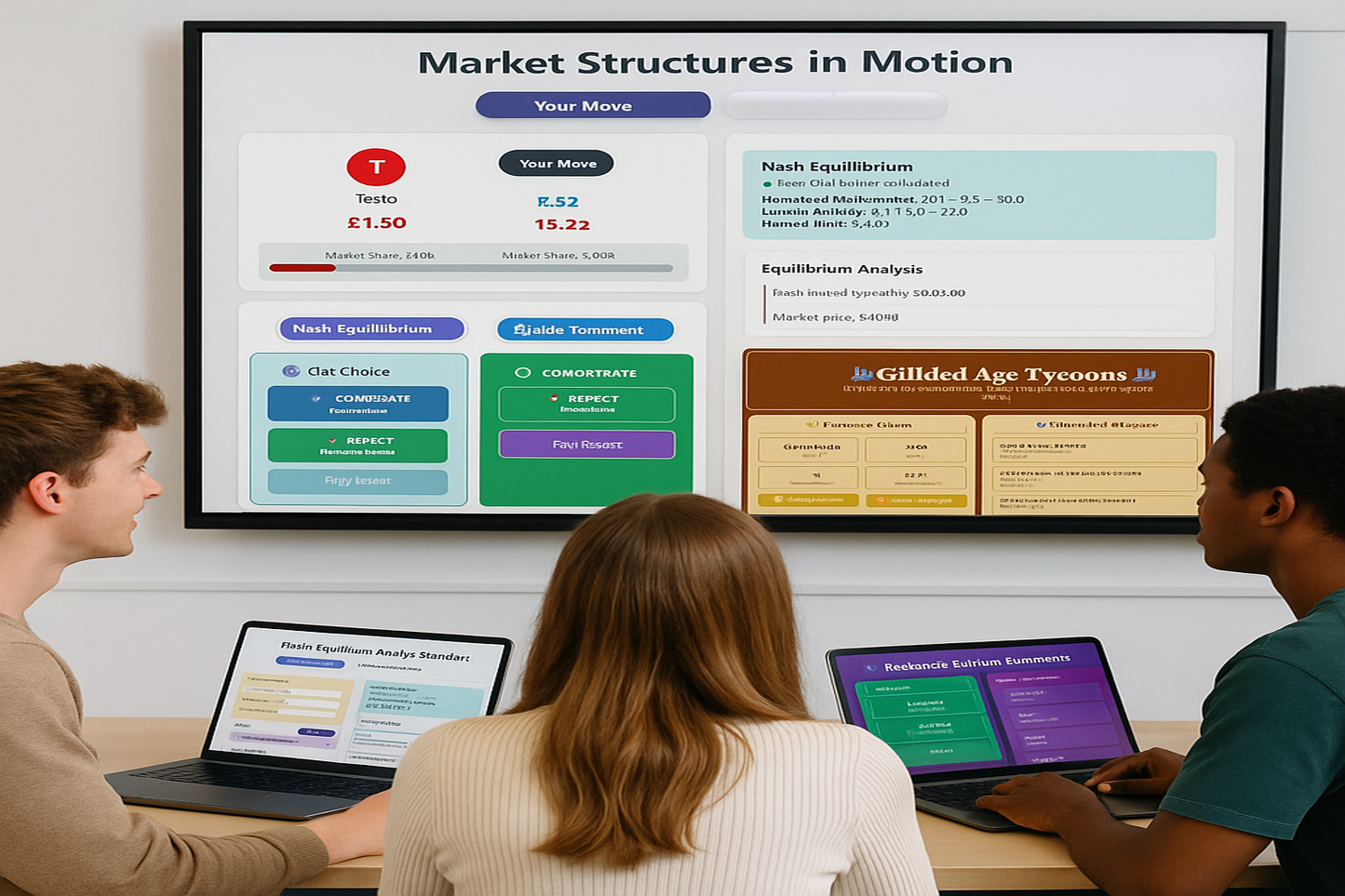BIZ-OMICS
Economics: The Market Structures Simulation Pack
Economics: The Market Structures Simulation Pack
Couldn't load pickup availability
Explore the world of market structures like never before with Market Structures in Motion — a powerful bundle of interactive simulations designed to bring economic theory to life. From oligopolies and monopolies to Nash Equilibrium and the Prisoner’s Dilemma, learners will test strategies, face competitors, and experience the dynamics of real-world markets in action.
All HTML simulators are accompanied by a supporting PDF document, designed to help teachers integrate the resource effectively into the classroom with ideas for use, key discussion questions, and reflection prompts.
Nash Equilibrium Market Simulator:
"Discover market strategy through interactive Cournot and Bertrand models!"
This dynamic simulator allows learners to manipulate variables, test strategies, and visually explore market outcomes under two classical economic models: Cournot (quantity competition) and Bertrand (price competition). Through a sleek, gamified interface, students act as competing firms and try to reach a Nash Equilibrium—the strategic point where no player benefits from changing their decision unilaterally.
Learning Outcomes
Understand the concept of Nash Equilibrium in different market structures.
Differentiate between Cournot and Bertrand competition and their outcomes.
Analyse the effect of market size, price sensitivity, and marginal cost on firm strategy.
Develop strategic thinking by experimenting with interactive variables and observing equilibrium responses.
Great for A-Level or undergraduate microeconomics, this tool brings abstract theory to life and fosters active learning through experimentation and simulation
Prisoner's Dilemma Tournament
"Trust, betray, or strategise—what kind of player will you be?"
This vibrant and accessible game lets players engage in the Prisoner's Dilemma—a core concept in game theory. Players select an opponent (ranging from Tit-for-Tat to Grudger to Always Defect) and make decisions over multiple rounds, seeing the consequences of cooperation versus betrayal in real-time. A tournament mode pits all strategies against each other to find the most successful in the long run.
Learning Outcomes
Master the logic and consequences of strategic interdependence.
Explore behavioral strategies like reciprocity, retaliation, and forgiveness.
Learn about dominant strategies, Nash equilibrium, and payoff matrices.
Develop an intuitive grasp of repeated games and evolutionary stability.
Ideal for introducing game theory, ethics in economics, or strategic decision-making in business. Perfect as a lesson starter, revision activity, or student-led experiment
UK Supermarket Oligopoly Wars:
"Can your decisions help dominate the market?"
In this hands-on simulation, learners enter the battlefield of UK supermarket competition. They take control of pricing, promotions, or store expansion decisions for one of the Big Four (Tesco, Sainsbury’s, ASDA, Morrisons) and watch as competitors react. With animated market shares and brand-driven visuals, it mirrors real-world oligopolistic interdependence.
Learning Outcomes
Understand price wars, non-price competition, and market share dynamics.
Explore oligopoly behavior and strategic interdependence in real markets.
Analyse the impact of promotional and expansion strategies on consumer demand.
Build intuition for how firms respond to rivals’ moves, reinforcing the kinked demand curve concept.
Perfect for GCSE or A-Level Business and Economics when covering market structures. Encourages group discussion and prediction before triggering reactions—a fantastic live classroom game
Gilded Age Tycoons Simulator:
"Rule the industrial revolution—strategise, expand, and survive the politics!"
Step into the shoes of a 19th-century industrialist during the Gilded Age. This rich simulation blends economics, politics, and history. Players grow an industrial empire, hire advisors like Rockefeller’s partners or muckraking journalists, lobby governments, respond to historical events, and react to random economic shocks. The UI is beautifully themed, and gameplay evolves with the era.
Learning Outcomes
Deepen understanding of industrial capitalism, monopoly growth, and government relations.
Explore the social and political context of economic decisions (e.g., tariffs, labor strikes, lobbying).
Learn how public opinion, technology, and political influence shape market outcomes.
Engage with historical economic events through strategic simulation.
Brilliant for cross-curricular learning: ideal for Economics, History, or Politics classes. Can be used in project-based learning, thematic units on the Gilded Age, or flipped classrooms
Hotelling’s Location Game:
Hotelling’s Location Game is an interactive web-based simulation that brings the classic model of spatial competition to life. Designed for A-Level, IB, and undergraduate Economics and Business students, this game allows learners to experiment with how two firms (ice cream vendors) choose their location on a linear street to maximize their market share.
As players drag Vendor A and Vendor B along the street, they see how customer distribution changes in real-time—and discover why competing firms often cluster near each other, even when it seems counterintuitive.
Learning Outcomes:
By engaging with the Hotelling’s Location Game, learners will:
Understand Hotelling’s Law and why firms in competitive markets often position themselves near the center.
Explore strategic decision-making in duopoly settings where customer proximity matters.
Identify and interpret a Nash Equilibrium, where neither player can improve by changing their position unilaterally.
Evaluate the trade-offs of different strategies, and see how market share responds to location changes.
Connect theory to real-world scenarios, like supermarket chains, fast food restaurants, or political campaign strategies.
Strategic Card Game Simulator:
The Strategic Card Game Simulator is a fast-paced, visually engaging simulation that introduces learners to the fundamentals of game theory through competitive play. Two players—Red and Black—must choose a card each round, with unique, asymmetric rules determining the winner. Learners must explore patterns, calculate win probabilities, and uncover strategic insights through manual gameplay or automated simulations.
It’s a battle of logic, luck, and strategic inference—perfect for flipping the classroom or igniting discussion.
Learning Outcomes
By playing and analyzing the Strategic Card Game, learners will:
Apply game theory principles to a non-zero-sum, asymmetric strategic situation.
Investigate equilibrium strategies and understand pure versus mixed strategies.
Analyze asymmetry in win conditions and its impact on expected outcomes.
Interpret empirical data from simulations to form and test strategic hypotheses.
Develop probabilistic reasoning, calculating win ratios and drawing conclusions from simulations.
Share


